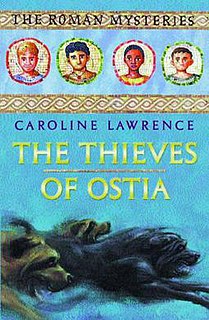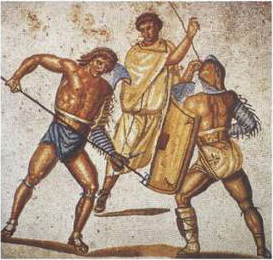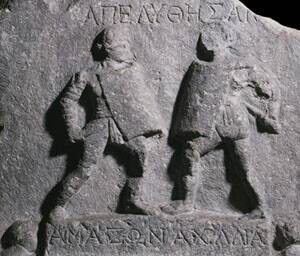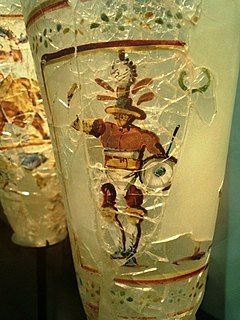
A gladiator was an armed combatant who entertained audiences in the Roman Republic and Roman Empire in violent confrontations with other gladiators, wild animals, and condemned criminals. Some gladiators were volunteers who risked their lives and their legal and social standing by appearing in the arena. Most were despised as slaves, schooled under harsh conditions, socially marginalized, and segregated even in death.

The Colosseum is an oval amphitheatre in the centre of the city of Rome, Italy, just east of the Roman Forum. It is the largest ancient amphitheatre ever built, and is still the largest standing amphitheatre in the world today, despite its age. Construction began under the emperor Vespasian in 72 and was completed in 80 AD under his successor and heir, Titus. Further modifications were made during the reign of Domitian. The three emperors that were patrons of the work are known as the Flavian dynasty, and the amphitheatre was named the Flavian Amphitheatre by later classicists and archaeologists for its association with their family name (Flavius).
Titus Annius Milo was a Roman political agitator. The son of Gaius Papius Celsus, he was adopted by his maternal grandfather, Titus Annius Luscus. In 52 BC, he was prosecuted for the murder of Publius Clodius Pulcher and exiled from Rome. He was unsuccessfully defended by his friend, Marcus Tullius Cicero, in the speech Pro Milone.

The Gloster Gladiator is a British-built biplane fighter. It was used by the Royal Air Force (RAF) and the Fleet Air Arm (FAA) and was exported to a number of other air forces during the late 1930s.

The Forum Boarium was the cattle forum venalium of ancient Rome. It was located on a level piece of land near the Tiber between the Capitoline, the Palatine and Aventine hills. As the site of the original docks of Rome, the Forum Boarium experienced intense commercial activity.

The Roman Mysteries is a series of historical novels for children by Caroline Lawrence. The first book, The Thieves of Ostia, was published in 2001, finishing with The Man from Pomegranate Street, published in 2009, and totaling 17 novels, plus a number of "mini-mysteries", spinoffs, and companion titles.

A retiarius was a Roman gladiator who fought with equipment styled on that of a fisherman: a weighted net, a three-pointed trident, and a dagger (pugio). The retiarius was lightly armoured, wearing an arm guard (manica) and a shoulder guard (galerus). Typically, his clothing consisted only of a loincloth (subligaculum) held in place by a wide belt, or of a short tunic with light padding. He wore no head protection or footwear.

Asterix the Gladiator is the fourth volume of the Asterix comic book series, by René Goscinny (stories) and Albert Uderzo (illustrations). It was first serialized in the magazine Pilote, issues 126–168, in 1962.

The gladiatrix is the female equivalent of the gladiator of ancient Rome. Like their male counterparts, gladiatrices fought each other, or wild animals, to entertain audiences at various games and festivals. Very little is known about them. They seem to have used much the same equipment as male gladiators, but were heavily outnumbered by them, and were almost certainly considered an exotic rarity by their audiences. They seem to have been introduced during the very late republic and early empire, and were officially banned as unseemly from 200 AD onwards. Their existence is known only through a few accounts written by members of Rome's elite, and a very small number of inscriptions.

Simon Scarrow is a British author. Scarrow completed a master's degree at the University of East Anglia after working at the Inland Revenue, and then went into teaching as a lecturer, firstly at East Norfolk Sixth Form College, then at City College Norwich.

Gladiator is a 2000 epic historical drama film directed by Ridley Scott and written by David Franzoni, John Logan, and William Nicholson. The film was co-produced and released by DreamWorks Pictures and Universal Pictures. DreamWorks Pictures distributed the film in North America while Universal Pictures released it internationally through United International Pictures. It stars Russell Crowe, Joaquin Phoenix, Connie Nielsen, Ralf Möller, Oliver Reed, Djimon Hounsou, Derek Jacobi, John Shrapnel, Richard Harris, and Tommy Flanagan. Crowe portrays Roman general Maximus Decimus Meridius, who is betrayed when Commodus, the ambitious son of Emperor Marcus Aurelius, murders his father and seizes the throne. Reduced to slavery, Maximus becomes a gladiator and rises through the ranks of the arena to avenge the murders of his family and his emperor.

Star Gladiator - Episode 1: Final Crusade is a 1996 weapon-based 3D fighting game released by Capcom for the PlayStation-based ZN-1 arcade hardware. It was Capcom's first in-house polygonal fighting game. A PlayStation port was released in October 1996. It was followed by a single sequel, Plasma Sword: Nightmare of Bilstein, in 1998.

The Ludus Magnus was the largest of the gladiatorial schools in Rome. It was built by the emperor Domitian in the late first century C.E., alongside other building projects undertaken by him such as three other gladiatorial schools across the Roman Empire. The training school is situated directly east of the Colosseum in the valley between the Esquiline and the Caelian hills, an area already occupied by Republican and Augustan structures. While there are remains that are visible today, they belong to a reconstruction that took place under the emperor Trajan where the Ludus plane was raised by about 1.5 metres. The Ludus Magnus was essentially a gladiatorial arena where gladiators from across the Roman Empire would live, eat, and practice while undergoing gladiatorial training in preparation for fighting at the gladiatorial games held at the Colosseum.

A hoplomachus was a type of gladiator in ancient Rome, armed to resemble a Greek hoplite. The hoplomachus would wear a bronze helmet, a manica on his right arm, loincloth (subligaculum), heavy padding on his legs, and a pair of high greaves reaching to mid-thigh. His weapons were the spear and a short sword. He was often pitted against the murmillo, perhaps as a re-enactment of Rome's wars in Greece and the Hellenistic East. The name hoplomachus means 'armored fighter'. The small, round shield was as much a weapon as a sword or spear, not unlike the original hoplites, who used it primarily for defensive purposes, but also employed it in their charges, using it to ram their opponents at the onset of a fight. They wore no shoes so the sand would chafe their feet, presenting them a greater challenge.

No. 65 Squadron was a squadron of the Royal Air Force.

Warriors of the Year 2072 is a 1984 Italian science fiction film directed by Lucio Fulci. The film is set in the 21st century, where Romans have found a new way to handle criminals: by having them fight each other like gladiators on motorcycles on national television. The film was based on a trend of Italian cinema to develop stories of futuristic barbarians after the popularity of the films Mad Max and Escape from New York.

Gladiator: Street Fighter is the second book in the Gladiator Series, by Simon Scarrow.
Nazzareno Zamperla was an Italian actor and stuntman.

The Cavillargues medallion is a terracotta relief medallion or plaque of the 2nd or 3rd century, 16 centimetres (6.3 in) across, made under the Roman Empire and found in modern France. It depicts a gladiatorial combat between a retiarius and a secutor. The medallion has been studied by American historian Anthony Corbeill and he believes it shows a games official signalling pollicēs premere, the granting of mercy to fighters whose combat ends in a draw.

















